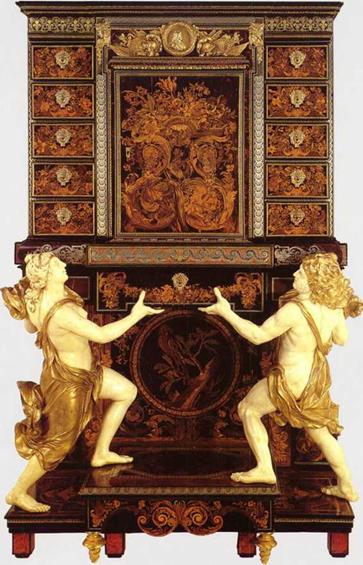How. therefore, should we visualize Boulle’s work prior to 17(H)? Various references in the records mentioned indicate that Boulle was making the wooden floral marquetry so much in favour in Paris in the 1680s. Thus in 1720 the fire destroyed ‘five boxes filled with different flowers, birds, animals, leaves and decorative elements in wood in all sorts of natural colours. mostly made by Sr. Boulle the Elder in his youth’. In the 1715 inventory these woods are itemized as ‘about twenty-five large cords of bois jaune. a number of roots of ash. six split logs of bois rouge or sandalwood and various pieces of stetin, ten cases of sawn wood in mixed sheets such as box. thorn, barberry. holly. Brazil and others’.
Boulle’s work in this technique has great stylistic
 /491 Cabinet commemorating the victory of a French prince, probtibly an allusion to the Battle of Steinkerque in 1693. at which the Due de Chartres, the Due de Bourbon and the Prince de Conti
/491 Cabinet commemorating the victory of a French prince, probtibly an allusion to the Battle of Steinkerque in 1693. at which the Due de Chartres, the Due de Bourbon and the Prince de Conti
|
|

unity (armoire in the Louvre [531; cabinets at Versailles or at the Cleveland Museum of Art. Drum – lanrig Castle or the J. Paul Getty Museum [49] and Wallace Collection; bureaux at Longleat and formerly in the Helft Collection [50)). having recurring decorative motifs, such as vases of flowers or birds perched on a branch, throughout. These motifs are also found on furniture by contemporaries such as those, for example, supplied by Gole in about 1680. or those supplied by Gaudron for the Crown in about 1690. However, marquetry by Boulle is of a finer quality and more naturalistic and finely detailed. His masterpiece is a marquetry panel, remounted in the middle of the eighteenth century on an English cabinet. now in the Bowes Museum at Barnard Castle [511. The style is close to that of Monnoyer. with very fullblown flowers, birds, butterflies, a cockerel and a dog. According to the deed of 1715. Boulle had in his possession one hundred and seventy sketches and studies of flowers taken from life and about fifty sketches of birds painted from life by Patel the Younger, which served him as models, as well as numerous flower paintings by Baudcsson. mentioned in 1732. One
would like to know the origin of the two ‘Hercules Cabinets’ (J. Paul Getty Museum [491and Drumlanrig Castle). The presence of fleur-de-lys on the frieze would indicate that they were made for a member of the royal family. The theme of Hercules would suggest a heroic occasion, a theme taken up in the marquetry of the central panel on which a cockerel triumphs over a lion and an eagle. The theme is clear: the allusion is to a French victory over Spain and the Holy Roman Empire. This could refer to the victory of Steinkerke in 1693. which was regarded at the time as a personal triumph for the young princes of the House of Bourbon, the Due de Chartres, the Due de Bourbon and the Prince de Conti. The bureau at
(511 luirge marquetry panel, c. 1690; reapplied to the front of an English cabinet in the eighteenth century. Probably the finest marquetry picture by Boulle, this panel was inspired by paintings by Jean-Baptiste Monnoyer. IBarnard Castle, County Durham; Bowes MuseumI
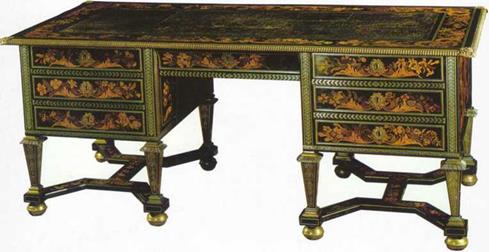
|
|
|
||

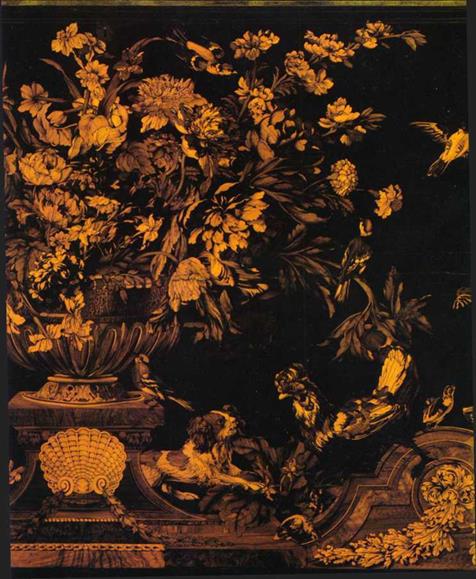
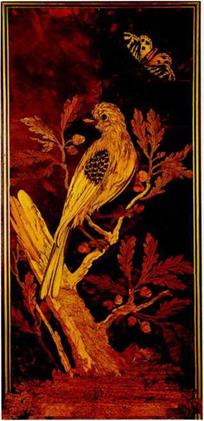

Longleat must also be dated to the 169()s. It is decorated in parts with horn stained to resemble lapis, a technique perfected by Cucci in about 1685-88, which still appeared as newsworthy to the Swedish envoy Cronstrom in 16%.
Furniture veneered in plain wood represents a large part of the workshop’s production. The Deed of 1715 mentions many of them (‘another commode in palisander… ordered by M. de la Croix’, ‘a bureau in amaranth ready for gilding, made for M. de Cotie’, ‘a serre-papiers in amaranth with three doors ordered by the Marquis de la Vicuville’). The accounts of the Bati – ments du Roi record an armoire in bois violet supplied by Boulle to Marly in 17(X). as well as a commode in amaranth supplied in 1714 for Fontainebleau. Finally, there are numerous mentions in the inventories of Boulle’s principal clients of pieces in palisander or in ‘bois de violette’. woods which were at that time frequently confused with amaranth. An example of this type of furniture is a commode in palisander [63], a drawing for which is in the Musee des Arts Decoratifs.
From the meagre chronological data at our disposal. it is difficult to gain an idea of the role played by Boulle in the development of three new types of furniture which appeared at the end of the seventeenth century: the commode, the bas d’armoire and the bureau plat. Commodes had already been in existence for about fifteen years when Boulle supplied his first examples to Trianon in 1708. In the daily entries of the Garde-Meuble Royal, two commodes called ‘tables en bureaux’ in walnut appeared in 1693, followed in 1695 by a commode in floral marquetry supplied by Gau – dron for Marly. In the same way the bas d’armoire in walnut or marquetry appeared in the royal residences in about 1688 and was well distributed by about 1695, about ten years before any examples by Boulle. which are not recorded before 17(H) (in an official document of 17(H). the ‘declaration somptuaire’ of Boulle’s workshop. four low armoires arc mentioned).
On the other hand. Boulle definitely played a role in the creation of a piece of furniture popular throughout the eighteenth century, the bureau plat with three drawers. This was the last transformation of the so – called bureau Mazarin’, as well as the large bureaux on eight round or square tapering legs made by Gole or Gaudron. which are mentioned in the Royal Archives up to about 1710. Boulle would seem to have designed this type before 1710. In 1711. in the inven-
/52/ Detail of the right side of the armoire shown at /5.)/; the marquetry is particularly realistic and detailed

ЯНркйЯ
|
|
|
|
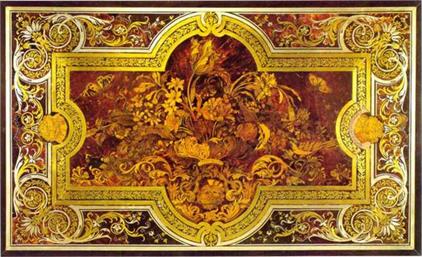
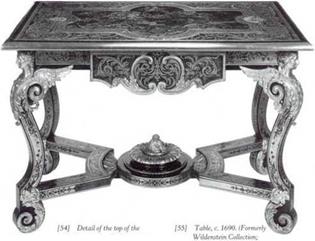

tory of Jean Phelipeaux, one of his clients, a bureau of this type is described as a large bureau in marquetry with gilt-bronze mounts, covered with black velvet, fitted with three drawers’. Daniel Alcouffe has discovered that in about 1713 the Verany de Varenne. dealers in the Place Dauphine. offered for sale ‘a large bureau made by Boul (sic) decorated with gilt-bronze mounts, with a tortoiseshell ground’. However, it would seem improbable that this type of desk was designed before 1700. There is a drawing by Gilles – Marie Oppenord in the Cooper-Hcwitt Museum which served as a preliminary study for these desks and it is known that he only returned from Italy in 1699.
If Boulle’s role as the designer of new types of furniture is uncertain, his role in the evolution of furniture styles is clear. As opposed to the massive forms of French furniture dating from 1680 to 17(X), he created dynamic forms, sometimes of a lightness that prefigures the rococo. The curved line not only affects the decoration on the surface of a piece of furniture but also animates its form. The cabriole legs, the concave aprons and the swelling forms that appear in his work of the years 17(X)-25 all herald the Regence style.

